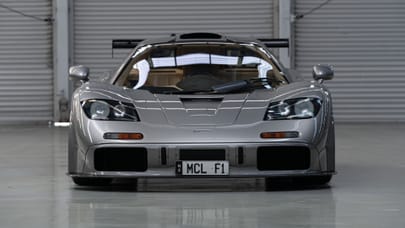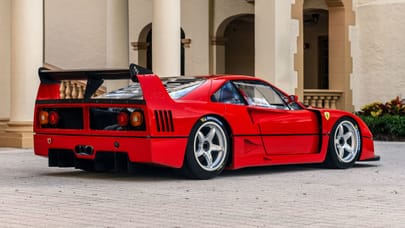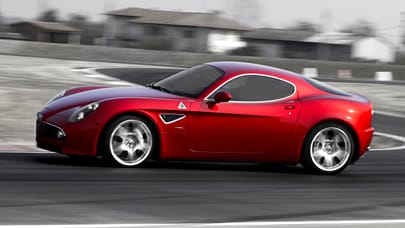
Top Gear's coolest racing cars: Ferrari 250 Testa Rossa
A true great, and now one of the world's most sought after Ferraris


Forget Formula One: in the 1950s and early 1960s, motorsport’s centre of gravity was the sports car world championship. And it was in this fiery crucible that the name Ferrari first became truly mythologised.
The Scuderia produced a bewildering array of racing cars during this era, often mixing and matching components, and developing ad hoc solutions as the need arose. However, the 250 Testa Rossa elevates itself above the rest on a purely empirical basis thanks to its three overall wins at Le Mans (1958, ’60, and ’61), leading to constructor’s titles for Ferrari in those same years, but also because the TR is about as beautiful as any racing car has ever been. (Feel free to nominate your choices below…)
Only 34 were made, most survive (although at least one was immolated not once but twice, and another had to endure the ignominy of seeing its V12 replaced with a Chevy V8), and they are now amongst the most desirable and valuable of all Ferraris in the ultra high-end collector’s market. That’s partly down to narrative and back story, things the mid-1950s competition scene was scarcely lacking in. It was also a time when some of Ferrari’s most revered drivers – Wolfgang Von Trips, Peter Collins, Phil Hill, Mike Hawthorn – also competed in world sports car racing.
Advertisement - Page continues below
The 250 TR emerged partly as a response to one of the most horrific chapters in motor racing’s often messy history: the death of Pierre Levegh and 83 spectators in the 1955 Le Mans 24 hours race, when the hapless, under-pressure French driver launched his Mercedes off Lance Macklin’s Austin-Healey, hitting a wall and showering the crowd in flaming debris. There was disaster again in 1957, during which Alfonso de Portago’s Ferrari crashed out when a tyre exploded, killing himself, his co-driver and 10 spectators, including five children. (The Vatican was so appalled it accused Enzo Ferrari of devilry, and a manslaughter charge hung over him and tyre supplier Englebert until 1961.)
The FIA had no choice but to respond to the gathering storm, so a limit of 3.0-litres was imposed on the top-level sports cars for the 1958 season. In fact, a prototype 250 Testa Rossa made its debut at the Nürburgring 1000km in May 1957, and finished 10th with Masten Gregory and the less competitive Olinto Morolli driving. It also ran as high as second at Le Mans the following month before retiring, but went well again at a race in Venezuela.

Ferrari had explored using a V6 and a quad-cam V12, and those early cars – chassis numbers 0666TR and 0704TR – were ameliorated using bits from extant Ferrari racers such as the 250 GT, 290MM, the four-cylinder 500 TRC, and 335. But ultimately Ferrari settled on the by-now well-proven 3.0-litre SOHC V12, designed by the great Gioacchino Colombo, and prioritised reliability over the pursuit of speed or risky technological innovations. He also wanted the growing legion of privateers to buy and run the car, leaving the factory free to contest the most important races. The name, of course, refers to the swept volume per cylinder, and the distinctive colour of the valve covers.
Thus this most feted of endurance racing cars initially made do with drum brakes, a robust chassis (although at 794kg it was hardly porky), a four-speed gearbox, and a live-axle rear end suspended on leaf springs. Hardly state-of-the-art, even in 1958.
It didn’t matter. The best-known Testa Rossas featured the dramatic ‘pontoon’ bodywork, whose scooped-out front wings were an improvised aid to brake cooling carried out by legendary Modenese fabricator Sergio Scaglietti. When it became apparent that this configuration wasn’t stable enough at high speeds, more conventional bodywork was introduced. Later works cars also gained a De Dion rear axle.
Advertisement - Page continues below
1958 was a spectacular year for the Testa Rossa, now named TR58. There were wins in Buenos Aires, Sebring and on the Targa Florio, although Aston Martin’s equally vaunted DBR1 – with the storied Stirling Moss/Jack Brabham driver pairing – beat the red cars at the Nürburgring. Ferrari, as ever prone to operatic rage when things went awry, insisted that the organisers’ cheap fuel cost the Scuderia certain victory. Phil Hill and Olivier Gendebien redressed the balance with an overall win at Le Mans.
With 19 cars built to this point, Ferrari decided to stop supplying customer cars to focus instead on a works effort (the earlier cars enjoyed a successful after-life on the US SCCA calendar). 1959’s TR59 featured a reworked design by Pininfarina, but rather than Scaglietti, who was flat-out fabricating Ferrari’s increasingly sought-after road cars, this time the work was done by the less well-remembered but equally inspired Medardo Fantuzzi. It also gained a new Valerio Colotti-designed five-speed gearbox and disc brakes, but had its work cut out against the DBR1 (to date, Aston’s only outright win at Le Mans came that year).
In 1960, Ferrari revised three of the TR59s to create the hybrid TR59/60, and premiered the much more advanced TRI 60 at Le Mans, the first Ferrari racer to feature fully independent suspension. Despite failing to win that year’s Targa Florio or Nürburgring 1000km, there was a one-two at Le Mans, Paul Frere and Olivier Gendebien leading Ricardo Rodriguez and André Pilette home, and another championship title for Ferrari.

1961’s TRI61 was effectively an all-new car, despite the name, and used a sophisticated spaceframe chassis and more aero-efficient body. But despite his famous reticence about the mid-engined format – ‘the ox pulls the cart, it doesn’t push it’, to paraphrase Il Commendatore – the arrival of the 246 SP marked the beginning of the end for the front-line front-engined sports car. Ferrari may have scored its sixth Le Mans win with 1962’s 330 TRI/LM, but it would be the last for the Testa Rossa name and the last ever to be scored by a car with the engine mounted upfront.
Nevertheless, a hit rate of 10 wins out of 19 championship races entered seals the 250 Testa Rossa’s status in the Ferrari firmament. This was a truly golden car in a golden era for sports car racing. No rose-tinted spectacles required here
Ferrari 250 Testa Rossa (1958)

Engine: 2953cc, 3.0-litre V12, six Weber carbs, 300bhp
Weight: 794kg
Performance: top speed 161mph, 0-60mph 6.0 seconds
Technical team: engine by Giacchino Colombo, bodywork designed by Pininfarina, fabricated by Scaglietti
Drivers: Peter Collins, Mike Hawthorn, Luigi Musso, Wolfgang Von Trips, Olivier Gendebien, Phil HillHead back to TopGear.com next Monday for the fifth instalment.
Trending this week
- Car Review
BMW 1 Series
- Top Gear's Top 9
Nine dreadful bits of 'homeware' made by carmakers







